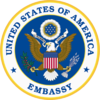Embassy of the United States, Luxembourg
| Embassy of the United States, Luxembourg | |
|---|---|
 
|
|
| Alternative names | Dolibois House |
| General information | |
| Address | 22 Boulevard Emmanual Servais |
| Town or city | Luxembourg City |
| Country | Luxembourg |
| Current tenants | David McKean, Ambassador (since 2016) |
| Completed | 1922 |
| Owner | United States Department of State |
| Design and construction | |
| Architect | Gust Schopen |
| Website | |
| http://luxembourg.usembassy.gov | |
The Embassy of the United States of America in Luxembourg City is the diplomatic mission on the United States in Luxembourg. Since 1944, following the liberation of Luxembourg in World War II, both the embassy and Ambassador's residence have been located in the Dolibois House, named after John E. Dolibois, Ambassador to Luxembourg 1981–1985.
1922, steel magnate Alfred Lefevre and Albertine Reckinger purchased the property at 22 Boulevard Emmanuel Servais, and built a maison de maître — a grand family house. Designed by Luxembourgish architect Gust Schopen, the house's opulence reflected the wealth Luxembourg’s steel industry, centered in Esch-sur-Alzette. However, for unknown reasons, the Lefevres never inhabited their new estate, and in 1929, sold it to the German government, who used it as their embassy.
At 4:35 a.m. on 10 May 1940, Nazi Germany invaded Luxembourg. Within hours, the tiny nation had been annexed entirely. Adolf Hitler then appointed Gustaf Simon as gauleiter (governor), and he set up base at the Lefevre mansion. Simon began a campaign to wipe out Luxembourgish language and culture, all the while hosting such names as composer Richard Strauss at the residence.
On 10 September 1944, the United States Army liberated Luxembourg City. The Lefevre house, in the meanwhile, was used as barracks for American soldiers. In the days following the Battle of the Bulge, the American Chargé d'Affaires to Luxembourg, George Platt Waller, returned after having been forced out in 1941, reestablishing the diplomatic connection between the US and Luxembourg.
...
Wikipedia
